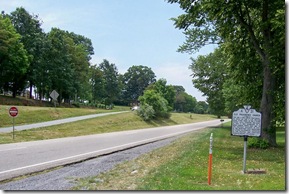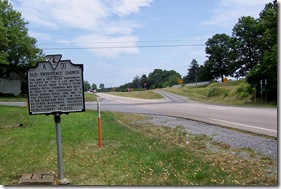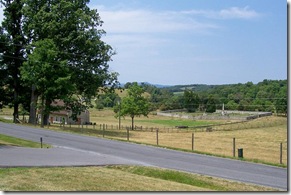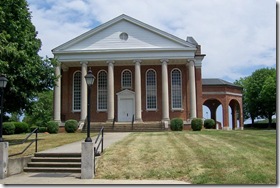 Marker No. A-31
Marker No. A-31
Augusta County, VA
Marker Text: Two and a half miles northwest. As early as 1748, a log meeting house stood there. In 1793 a stone church (still standing) was built. In 1859 it was succeeded by a brick church, which gave way to the present building in 1918. In the graveyard rest ancestors of Cyrus McCormick, inventor of the reaper, and fourteen Revolutionary soldiers.
Location: On U.S. Route 11 (Lee Jackson Highway) at County Route 620 (Spottswood Road), 1.4 miles north of Steeles Tavern. The church is located west on Spottswood Road at intersection with Old Providence Road (VA Route 919) Erected by the Virginia Conservation Commission in 1939.
Photo taken looking south on Route 11.
I have not posted about a church lately so today, I will cover one the remaining old church structures in Augusta County, VA. Historical Road Marker A-31 located on U.S. Route 11 between the villages of Greenville and Steeles Tavern tells briefly of the history of Old Providence Associate Reformed Presbyterian Church. This marker among others in the valley points out the significance of Scots-Irish Presbyterians in the settlement of the Shenandoah Valley and their presence here for more than 250 years.
As settlers into the Shenandoah Valley traveled south from Pennsylvania on the Great Wagon Road, German Lutherans and Scots-Irish Presbyterians were the main ethic groups to move into the valley in 1700's bringing their religion and cultural influences that still persist in the valley today.
Old Providence Church original stone church building across the road from the current church building. Click any photo to enlarge.
No less than half a million Scotch-Irish people came to the United States between 1700 and 1775 seeking religious liberty denied them in the Britain, first arriving in Pennsylvania. Augusta and Rockbridge County were settled primarily by Scotch-Irish Presbyterians. In 1720, the first mass migration from Ireland into America began. A second wave of migration began about 1760 and lasted until the outbreak of the American Revolution.
Photo taken looking north on Route 11, road to the left will take you to the church.
Around 1732, these people initially moved to the Shenandoah Valley south of the Potomac for two reasons, they encouraged to settle here by the colonial government who want they to serve as a buffer between the Native American Indians in the area and the colonies to the east of the Blue Ridge Mountains. They also found the valley desirable, in order, to get away from the direct influence of the established Church of England before the Revolutionary War and gain some sense of religious freedom. Although religion was not completely free in Virginia, the Presbyterians found themselves virtually unmolested by the planters of eastern Virginia. They were encouraged to settle far up the Shenandoah River in the valley west of the Blue Ridge Mountains by the opening of the Beverly Manor and Borden's Grant, which eventually became Rockbridge and Augusta counties.
Another view of the Old Providence Church on the left and the old cemetery is on the right. Larger cemetery is across Spottswood Road from the current building.
What the sign fails to point out is that this congregation, which is more than 250 years old, lies at the heart of some of the richest Presbyterian history in the Shenandoah Valley. By the 1740s, one group of Presbyterian pioneers was worshiping in a log meeting house in close proximity to the present-day Old Providence Church located just west of the village of Spottswood.
By 1740, the presence of Scotch-Irish were well established in Rockbridge (then Orange County). The erection and establishment of Presbyterian churches was underway and calls were being placed for ministers. Families, such as, the McDowell's, McCormick's, and Houston's were among the early settlers. Most social interaction among the residents as they established their homes, farms and businesses centered around the local churchyard.
Dissension among early Presbyterian worshippers who were part of South Mountain Meeting House was not unusual. Several differences caused these early worshippers to divide into smaller groups. One of the first problems concerned revivals and whether or not the religious fervor and excitement of revivals should be a part of worship services. Part of their conservatism was with church music. The only songs allowed during worship service were the psalms and no musical instruments were allowed in the church. This heavier emphasis on psalmody set them apart from the mainline Presbyterians. The New Side group, which favored revivals and the use of newer developing hymns and music withdrew to form New Providence Presbyterian Church near Brownsburg.
Current Old Providence Church building across Old Providence Road from the older stone church.
Apparently a more conservative Old Side group continued to hold services in the Spottswood area and in 1762 a group calling itself Old Providence petitioned the more conservative Associate Presbytery in Pennsylvania asking for pastoral supplies. For a number of years the two groups of conservative Presbyterians, one called Associate Reformed Presbyterian and one called Reformed, worshipped here.
In 1793 the Old Providence worshippers purchased a two-acre tract of land and shortly thereafter built a stone meeting house. That structure, which remains on the church grounds today, served as the house of worship until the 1850s when a new brick church was built. The stone meeting house then continued to be used as a social hall, a high school, and a private dwelling. In 1959 an electrical short caused a fire that destroyed much of the structure. Only the weakened walls were left standing. The congregation rallied together, however, to reconstruct the building, which was placed on the Virginia Landmarks Register and National Register of Historic Places in 1972.
While the stone building remains as the second house of worship at the site, the third structure, a brick building erected in the 1850s has been torn down to make way for the current church building.





No comments:
Post a Comment